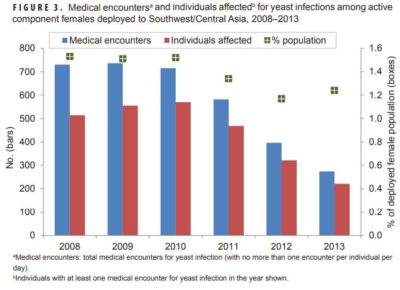BETHESDA, MD — For women serving in challenging environments with limited access to clean water, sanitation and medical facilities, knowing how to prevent, diagnose and treat urogenital infections is essential. Prompt recognition of these infections prevents them from worsening, with immediate impact on force readiness and potential long-term effects on the war-fighter’s health and reproductive future.
While some women are able to receive support and treatment from unit medics and others go to sick call or central medical facilities for the most serious infections, the DoD recognized 20 years ago that the most effective point of care was with the servicemember herself.
“Enabling female war-fighters with greater control of their bodies, through knowledge and access to an innovative kit designed to self-test, self-identify, and self-treat common urogenital symptoms, while serving in austere environments, is critical to force health,” said Elizabeth Kostas-Polston, PhD, APRN, WHNP-BC, and associate professor at the Uniformed Services University of Health Services (USUHS), and colleagues in a recent article in the Journal of the American Association of Nurse Practitioners.1
Urogenital conditions rank among the leading reasons female war-fighters receive medical services or require evacuation, in part because a constellation of factors limits their access to appropriate sex-specific health care in their units. Those include lack of time and privacy, embarrassment, lack of female health care providers and low confidence in available health care providers, and perceived stigma, the authors wrote.
Frequent medical visits and evacuations also result from high rates of infection, but just how high remains unclear because of a combination of self-treatment, treatment from providers outside the military health system, and vague reporting of gynecological disorders in military records. It is clear, however, that bacterial vaginosis (BV), vulvovaginal candidiasis (VC), and urinary tract infections (UTI) are very prevalent during deployment. Available medical records indicate that each of these conditions affects at least 30% of deployed women.
Identifying these infections quickly is critical. The authors “found that for every additional episode of BV, the risk of chlamydia infection increased by 13% (95% confidence interval [CI]: 12%–14%) compared with women without BV. Additionally, for every additional episode of BV, the risk of gonorrhea increased by 26% (95% CI: 23%–28%).” Untreated UTIs, estimated to affect more than 30% of deployed women, can progress to kidney infection and require evacuation for care.
In-Field Testing
In 2015, Nancy Ryan-Wenger and Nancy Lowe created the Women in the Military Self-Diagnosis (WMSD) Kit to provide self-diagnostic capability and self-treatment guidance for women in the field without the supervision of medical personnel. They tested the willingness to use and outcomes from the kit in 265 women serving in the Army, Navy, Air Force, and Marines.2
In a two-factor, controlled trial that tested multiple levels of training to use the kit, they found that more intensive training provided no advantages over an approximately 20-minute video. Diagnostic and self-treatment accuracy were both approximately 80%, with overtreatment of 7.6% and under treatment of 12.5%. “Predeployment training with the WMSD Kit shows great promise for improving military women’s health during deployment,” they concluded.
Unfortunately, the kit never went further in production as one of the testing products was not available in the U.S. and another component was produced in China, which violated the U.S. Trade Agreement Act. A substitute kit has not been developed.
Today, at-home tests for vaginal pH, which can indicate whether an infection is likely yeast (normal pH of 3.8 to 4.5) or bacterial (pH above 4.5), are now available. While they cannot diagnose a yeast or bacterial infection, these tests could be used in conjunction with common symptoms of vulvovaginal infections, such as curdy discharge, itching, pain, odor, redness, and irritation and a decision-making tool to make a field self-diagnosis and determine appropriate treatment. Multiple UTI dipsticks are also available for at-home use and could reasonably be adapted for in-field purposes along with the presence of symptoms including intense urinary urgency with minimal output and a burning sensation on urination.
Kostas-Polston and her colleagues found that women in the Army were enthusiastic about a self-test, self-treatment kit. “This kit is a great idea because it would serve to minimize the stigma that comes along with being a female soldier,” one said. “When you have these kinds of issues the men start to talk, a woman gets stigmatized and labeled, and rumors are spread about the soldier. A kit like this would help stop this! Also, there is no reason why a woman could not use the kit, identify the infection, & treat it. This is a much-needed intervention for our soldiers.”
Another explained how it would simplify her preparation for going into the field. ‘I’m very prone to UTIs, BV, & yeast infections. I have to be extra careful when I go to the field because I will most likely get one or all of those. With this kit I would not have to worry about going to a provider in the middle of my training or seeing if I can get medication before the field event. Seriously, I LOVE this idea.”
To train women to use the kit in the field, the authors recommended providing sex-specific educational interventions and guidance through nurse practitioners prior to deployment. Such training could also be helpful before field exercises. But first, a kit is needed.
“To effectively counter radical terrorism, female war-fighters must operate effectively given the state of unconventional, irregular warfare,” the authors concluded. “It is of great importance to develop a tailored, urogenital, self-test/treatment kit that includes FDA-cleared, TAA-compliant, and durable in extreme conditions items that can be combined with a testing and diagnosis algorithm, and appropriate medications.”
- Kostas-Polston EA, Braun LA, Miedema J. Female warfighters’ perceptions of urogenital health in operational settings. J Am Assoc Nurse Pract. 2020 Nov;32(11):729-737. doi: 10.1097/JXX.0000000000000534. PMID: 33177334.
- Ryan-Wenger NA, Lowe NK. Evaluation of Training Methods Required for Military Women’s Accurate Use of a Self-Diagnosis and Self-Treatment Kit for Vaginal and Urinary Symptoms. Mil Med. 2015 May;180(5):559-64. doi: 10.7205/MILMED-D-14-00324. PMID: 25939111.



